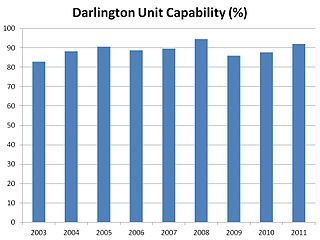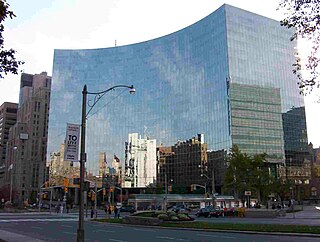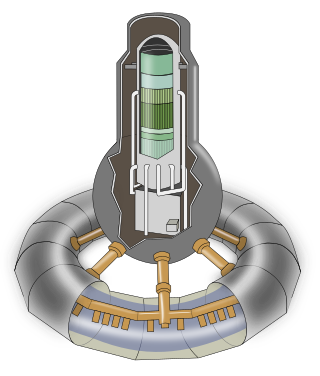Related Research Articles

The CANDU is a Canadian pressurized heavy-water reactor design used to generate electric power. The acronym refers to its deuterium oxide moderator and its use of uranium fuel. CANDU reactors were first developed in the late 1950s and 1960s by a partnership between Atomic Energy of Canada Limited (AECL), the Hydro-Electric Power Commission of Ontario, Canadian General Electric, and other companies.

A boiling water reactor (BWR) is a type of light water nuclear reactor used for the generation of electrical power. It is the second most common type of electricity-generating nuclear reactor after the pressurized water reactor (PWR), which is also a type of light water nuclear reactor.

Darlington Nuclear Generating Station is a Canadian nuclear power station located on the north shore of Lake Ontario in Clarington, Ontario. It is a large nuclear facility comprising four CANDU nuclear reactors with a total output of 3,512 MWe when all units are online, providing about 20 percent of Ontario's electricity needs, enough to serve a city of two million people. The reactor design is significantly more powerful than those used in previous CANDU sites at Pickering and Bruce, making its 4-unit plant the second-largest in Canada behind the 8-unit Bruce. It is named for the Township of Darlington, the name of the municipality in which it is located, which is now part of the amalgamated Municipality of Clarington.
The "Nuclear Power 2010 Program" was launched in 2002 by President George W. Bush in 2002, 13 months after the beginning of his presidency, in order to restart orders for nuclear power reactors in the U.S. by providing subsidies for a handful of Generation III+ demonstration plants. The expectation was that these plants would come online by 2010, but it was not met.

The advanced boiling water reactor (ABWR) is a Generation III boiling water reactor. The ABWR is currently offered by GE Hitachi Nuclear Energy (GEH) and Toshiba. The ABWR generates electrical power by using steam to power a turbine connected to a generator; the steam is boiled from water using heat generated by fission reactions within nuclear fuel. Kashiwazaki-Kariwa unit 6 is considered the first Generation III reactor in the world.
Nuclear power in Canada is provided by 19 commercial reactors with a net capacity of 13.5 gigawatt (GW), producing a total of 95.6 terawatt-hours (TWh) of electricity, which accounted for 16.6% of the country's total electric energy generation in 2015. All but one of these reactors are located in Ontario, where they produced 61% of the province's electricity in 2019. Seven smaller reactors are used for research and to produce radiopharmaceuticals for use in nuclear medicine.

The Economic Simplified Boiling Water Reactor (ESBWR) is a passively safe generation III+ reactor design derived from its predecessor, the Simplified Boiling Water Reactor (SBWR) and from the Advanced Boiling Water Reactor (ABWR). All are designs by GE Hitachi Nuclear Energy (GEH), and are based on previous Boiling Water Reactor designs.

Ontario Power Generation Inc. (OPG) is a Crown corporation and "government business enterprise" that is responsible for approximately half of the electricity generation in the province of Ontario, Canada. It is wholly owned by the government of Ontario. Sources of electricity include nuclear, hydroelectric, wind, gas and biomass. Although Ontario has an open electricity market, the provincial government, as OPG's sole shareholder, regulates the price the company receives for its electricity to be less than the market average, in an attempt to stabilize prices. Since 1 April 2008, the company's rates have been regulated by the Ontario Energy Board.

Michał Sołowow is a Polish billionaire businessman and rally driver. His industrial group has 18 production plants in 8 countries and sells products in more than 60 countries on six continents and has over 16,000 employees.

PRISM is a nuclear power plant design by GE Hitachi Nuclear Energy (GEH).

Small modular reactors (SMRs) are a class of small nuclear fission reactors, designed to be built in a factory, shipped to operational sites for installation and then used to power buildings or other commercial operations. The first commercial SMR was invented by a team of nuclear scientists at Oregon State University (OSU) in 2007. Working with OSU's prototype, NuScale Power developed the first working model, available to the US market, in 2022. The term SMR refers to the size, capacity and modular construction. Reactor type and the nuclear processes may vary. Of the many SMR designs, the pressurized water reactor (PWR) is the most common. However, recently proposed SMR designs include: generation IV, thermal-neutron reactors, fast-neutron reactors, molten salt, and gas-cooled reactor models.

Horizon Nuclear Power is a British energy company that was expected to build new nuclear power stations in the United Kingdom. It was established in 2009, with its head office in Gloucester, and is now owned by Hitachi.
GE Hitachi Nuclear Energy (GEH) is a provider of advanced reactors and nuclear services. It is headquartered in Wilmington, North Carolina, United States. Established in June 2007, GEH is a nuclear alliance created by General Electric and Hitachi. In Japan, the alliance is Hitachi-GE Nuclear Energy. In November 2015, Jay Wileman was appointed CEO.

Poland currently operates a single research reactor, Maria. It has no operational nuclear reactors for power production, but is to start construction of a plant with three Westinghouse AP1000 reactors in 2026, and is also intending to build small modular reactors.
The Office for Nuclear Regulation (ONR) is the regulator for the nuclear industry in the United Kingdom. It is an independent statutory corporation whose costs are met by charging fees to the nuclear industry. The ONR reports to the Department for Work and Pensions, although it also worked closely with the now-defunct Department of Energy and Climate Change.
Holtec International is a supplier of equipment and systems for the energy industry. Founded in Mount Laurel, New Jersey in 1986, Holtec International is a privately-held technology company with domestic operation centers in New Jersey, Florida, Ohio and Pennsylvania and worldwide in Brazil, India Japan, Mexico, Poland, South Africa, Spain, U.K. and Ukraine. It specializes in the design and manufacture of parts for nuclear reactors. The company sells equipment to manage spent nuclear fuel from nuclear reactors.

General Electric's BWR product line of boiling water reactors represents the designs of a relatively large (~18%) percentage of the commercial fission reactors around the world.

The Stable Salt Reactor (SSR) is a nuclear reactor design under development by Moltex Energy Canada Inc. and its subsidiary Moltex Energy USA LLC, based in Canada, the United States, and the United Kingdom, as well as MoltexFLEX Ltd., based in the United Kingdom.
References
- 1 2 "Status Report – BWRX-300" (PDF). GE Hitachi Nuclear Energy. IAEA. 30 September 2019. Retrieved 31 December 2023.
- ↑ "OPG advances clean energy generation project". 2021-12-02. Retrieved 2022-02-06.
- ↑ "OPG applies for construction licence for Darlington SMR". World Nuclear News. 2022-11-02. Retrieved 2022-11-06.
- ↑ "Firms partner to support BWRX-300 deployment in Poland". www.ans.org. Retrieved 2022-02-08.
- ↑ "Two Polish companies apply for regulator's opinion on SMR technology assessment - Nuclear Engineering International". www.neimagazine.com. Retrieved 2022-07-21.
- ↑ "Pierwszy reaktor jądrowy BWRX-300 może trafić do Polski w 2029 r." [The first BWRX-300 nuclear reactor could arrive in Poland in 2029.]. Money.pl (in Polish). 8 August 2022. Retrieved 2022-08-08.
- ↑ "Jest zielone światło dla małego atomu". wnp.pl (in Polish). Retrieved 2023-12-07.
- ↑ "Kärnfull teams up with GEH for SMR deployment : New Nuclear - World Nuclear News". www.world-nuclear-news.org. Retrieved 2022-03-25.
- ↑ "SaskPower Selects the GE-Hitachi BWRX-300 Small Modular Reactor Technology for Potential Deployment in Saskatchewan". www.saskpower.com. Retrieved 2022-06-27.
- ↑ "Fermi Energia Selected US-Japan Joint Venture as Nuclear Reactor Producer". ekspress.delfi.ee. Retrieved 2023-02-08.
- ↑ "Three More BWRX-300 SMRS Planned for Canada's Darlington Site". 7 July 2023.
- ↑ "BWRX-300 Small Modular Reactor | GE Hitachi Nuclear Energy".
- ↑ "The Evolution of the ESBWR". November 2010.